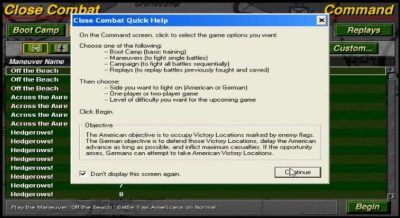25 Year Retrospective of the Close Combat Series (part one)
by Patrick S. Baker
“Take command of men who act like real soldiers” was the tag line on the Close Combat box.

When first released in 1996 Close Combat took the war game world by storm. It was not just one of the first real-time tactics/real-time strategy (RTT/RTS) war games, but also boldly claimed to be an accurate simulation of modern war. The game was developed by Atomic Games and published by Microsoft, and was one of the few games published by the software giant at that time.
It was originally announced as Beyond Squad Leader and was to be a digital sequel of Avalon Hill’s million-selling Advanced Squad Leader (ASL) board war game franchise. However, the companies’ affiliation was fraught and, eventually, Atomic and Avalon Hill parted ways. Atomic renamed the project Close Combat, and continued the development, with Microsoft coming in as publisher.
 Close Combat was a real-time computer war game depicting a set of small battles between the United States Army’s 29th Infantry Division and the Germany’s 352nd Infantry Division just after the invasion of Normandy during World War Two. The game had a top-down graphical perspective. The player took control of either side and directed infantry, crew-served weapons and armor through a drop-down menu with six commands: move, fire, move fast, defend, hide and smoke; movement was handled through a point and click interface.
Close Combat was a real-time computer war game depicting a set of small battles between the United States Army’s 29th Infantry Division and the Germany’s 352nd Infantry Division just after the invasion of Normandy during World War Two. The game had a top-down graphical perspective. The player took control of either side and directed infantry, crew-served weapons and armor through a drop-down menu with six commands: move, fire, move fast, defend, hide and smoke; movement was handled through a point and click interface.
Close Combat innovated in many areas of play and modeling when compared to earlier titles in the RTT/RTS computer game genre. The realistic modeling focuses on five areas of the game.
 Mental state of the soldiers: Close Combat used a psychological model for individual combatants within the game. The combatant’s morale was affected by many factors, such as being near leaders, having support from other units, coming under fire, taking casualties, or having no orders. Troops were in Stable Condition when in no danger. They might have been in Cowering Condition when under enemy fire. Or be Panicked when faced with dead or wounded buddies, under intense enemy fire, or near an overwhelming enemy.
Mental state of the soldiers: Close Combat used a psychological model for individual combatants within the game. The combatant’s morale was affected by many factors, such as being near leaders, having support from other units, coming under fire, taking casualties, or having no orders. Troops were in Stable Condition when in no danger. They might have been in Cowering Condition when under enemy fire. Or be Panicked when faced with dead or wounded buddies, under intense enemy fire, or near an overwhelming enemy.
The use of this psychological modeling made many tactics that were common in other RTT/RTS games, like the suicidal charge, near impossible in Close Combat. Further, in Close Combat, units would simply not obey bad orders, like advancing across open ground against a dug in enemy, or taking on a tank with just a rifle. Instead, the units would go to cover, retreat or even break and opt out of the battle totally.
Experience of the units: in the game new units, or new troops, would act and react more slowly and were more likely to panic or cower than veteran or experienced units. Thus, the green troops were less likely to succeed against veteran enemy troops than experienced troops.
 Ammunition supply: All units had limited ammunition; troops in heavy combat would quickly run out of ammo. When out of ammo, the unit sometimes resorted to hand-to-hand combat, but were more likely to surrender or flee. Later in the series unit could scavenge weapons and ammunition from the fallen, both friendly and enemy. In most RTT/RTS of the time, ammo was unlimited.
Ammunition supply: All units had limited ammunition; troops in heavy combat would quickly run out of ammo. When out of ammo, the unit sometimes resorted to hand-to-hand combat, but were more likely to surrender or flee. Later in the series unit could scavenge weapons and ammunition from the fallen, both friendly and enemy. In most RTT/RTS of the time, ammo was unlimited.
Physical Condition of soldiers: In Close Combat, troops were Healthy, Injured, Incapacitated, or Dead. Injured soldiers moved and fire more slowly than when. Incapacitated soldiers are so badly hurt they can no longer function. Dead is dead. In most RTT/RTS of the time the units are either fully functioning or dead.
 Stamina of soldiers: In the game, troops may be Rested. But when moving or fighting they become Winded, Winded soldier moved slowly until they could rest and returned to Rested condition. If the soldiers continue to exert themselves by running, moving or fighting they may become Fatigued. Fatigued soldiers moved and reacted slower than Rested soldiers for the remainder of the battle.
Stamina of soldiers: In the game, troops may be Rested. But when moving or fighting they become Winded, Winded soldier moved slowly until they could rest and returned to Rested condition. If the soldiers continue to exert themselves by running, moving or fighting they may become Fatigued. Fatigued soldiers moved and reacted slower than Rested soldiers for the remainder of the battle.
On its release, Close Combat was generally well received by the critics and was also a commercial success. One reviewer hailed the game as an intuitive combat simulation, praising its graphics and streamlined quality. Another stated that the game “looks, sounds and plays like nothing else.” Further, the games originality and tactical realism was lauded. However, the acclaim was not universal. Many reviewers criticized the slow and jerky scrolling, and hard to read graphics, with one critic noting that he “…often mistook the American soldiers for shrubs”.
 Some of the harshest criticism came from the hardcore Advanced Squad Leader fan-base, that expressed disappointment that the game was not a direct digital conversion of ASL. In response to this, the game’s chief designer later stated his goal had always been to recreate the spirit of Squad Leader, without directly adopting its design.
Some of the harshest criticism came from the hardcore Advanced Squad Leader fan-base, that expressed disappointment that the game was not a direct digital conversion of ASL. In response to this, the game’s chief designer later stated his goal had always been to recreate the spirit of Squad Leader, without directly adopting its design.
Another tough review said the game’s “realistic psychological model for the soldiers… is a potentially interesting wrinkle. The problem is it doesn’t work in practice…eventually some squad of grunts is too slow or simply doesn’t follow an order at all”, this was “frustrating and arbitrary.” This critique missed the whole point about the human factors modeling; which is that human reactions in modern combat are frequently frustrating and seemly random to the military’s leadership.
 Close Combat was named one of the top war or strategy games of 1996 by Computer Games Strategy Plus, Computer Game Entertainment and Inside Mac Games magazines. It was named Best Wargame of the Year by PC Gamer US.
Close Combat was named one of the top war or strategy games of 1996 by Computer Games Strategy Plus, Computer Game Entertainment and Inside Mac Games magazines. It was named Best Wargame of the Year by PC Gamer US.
The Success of the first Close Combat game also spawned a whole franchise of follow-on games.
